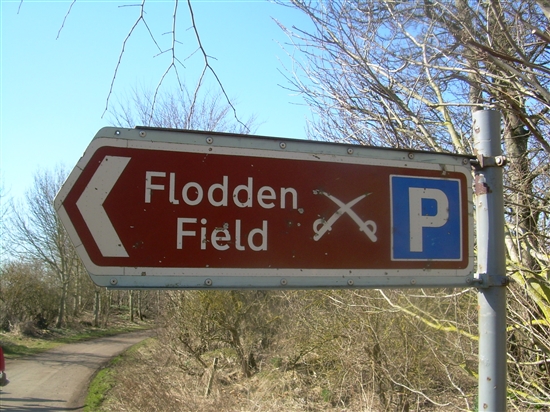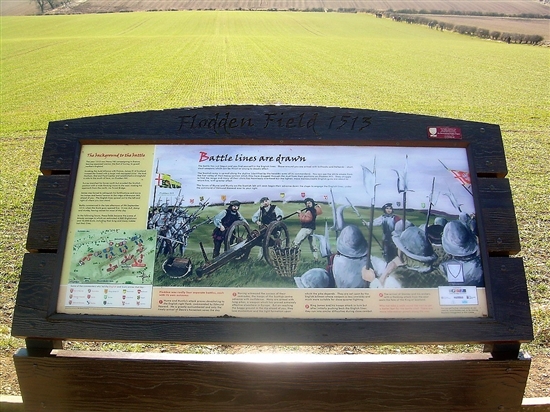Other pages about
Battle of Flodden
Battle of Flodden
9th September 1513
Name: Batle of Flodden
Date: 9 September 1513
War period: Early modern
Start time and duration: 4pm lasting several hours
Outcome: English victory
Armies and losses: English under Earl Surrey with around 26,000 men; Scottish under King James IV with 35-40,000 men. Losses: English: circa 4,000; Scottish: circa 10,000.
Location: securely located in the fields south of the village of Branxton and fought across open upland pasture / arable land.
Map details: Grid Reference: NT895371 (389596,637112); OS Landranger map: 75; OS Explorer map: 339
An invading Scottish army was heavily defeated and the Scottish King James IV was killed. The last time a reigning British monarch was killed in battle.
King Henry VIII of England acceded to the throne in 1509 and from the outset was keen to secure England's position on the Continental stage. To this end he joined an alliance with Spain and Pope Julius II against France in 1511. King James IV of Scotland was married to Henry’s sister but also had an alliance with France. When Henry invaded France in 1513 the French King Louis XII called upon James for assistance. James was persuaded to invade England and so divert troops away from the war on the continent.
Assisted with French arms, ammunition and some troops, James crossed into England in August with an army of up to 60,000 men. His intentions were to draw English forces north and so deplete the troops available for war in France. To this end he confined his activities to capturing the border castles of Etal and Ford, using the latter as his base, and sending raiding parties into the countryside. But Henry had anticipated an invasion from Scotland and had assembled his forces for the continental campaign mainly from the counties of southern England, leaving Thomas Howard, Earl of Surrey in command in the north.
In response to the Scottish invasion, the Earl of Surrey mustered troops from across the northern and midland counties. By early September there was an army of some 26,000 assembled at Alnwick. James's army had now shrunk, by desertion and through troops being detached for garrison duty, to 35-40,000. Surrey now issued a challenge to James, which was eventually accepted, with a battle to take place by the 9th September at the latest.
James moved his army to the steep hill of Flodden Edge. When Surrey arrived on 7th September and saw the tactical advantage the Scots had taken he requested James to take a more level ground where each had the same chance. Unsurprisingly James declined to move stating that he would ‘take and keep his ground at his own pleasure’.
In response, on 8th September Surrey marched his army in a wide sweep to the north-east, several miles east of the Scottish position and on the opposite side of the river Till. Now he could advance against the Scots from the north, avoiding the entrenched Scottish artillery which were facing south against the expected direction of English attack, and also stopping the Scottish army retreating across the border without engaging.
James saw this manoeuvre from his vantage point on Flodden Edge but it was not until the morning of the 9th that he realised Surrey's intent. He then ordering his army to turn about and march a mile to the north from Flodden Edge to Branxton Hill, which formed the northern edge of this area of high ground. As the English, somewhat delayed by the crossing of the Pattins Burn, drew up to the south of Branxton village on a slight rise below Branxton Hill the Scots were already in battle formation and ready to attack.
Despite initial Scottish success, the battle of Flodden was to prove a devastating defeat for the Scots. Casualties were very heavy and amongst the 10,000 killed were nine earls, thirteen barons, five heirs to titles, three bishops, two abbots and even the King himself.
The battlefield is now fully enclosed but remains as agricultural land, although there are several modern woodland plantations around the edges of the battlefield. Access is possible via several minor roads and permissive footpaths. A monument to the battle erected in 1910 stands on Piper's Hill and the Remembering Flodden Project (http://www.flodden.net) has erected a number of information boards across the battlefield.
- Historic England Battlefields Register CLICK HERE
- Historic England battlefield report for Battle of Flodden 1513


































